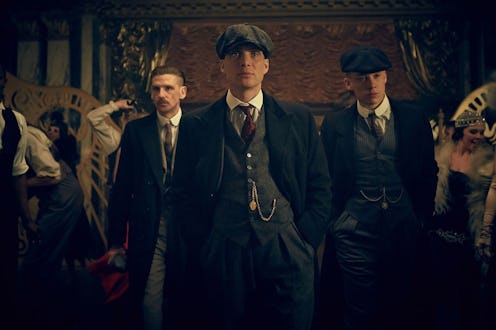
Peaky Blinders, the BBC Two program now streaming on Netflix, combines three of my favorite things: Cillian Murphy’s face; English accents; and theatrical period productions paired with bluesy-rock, ass-kickin’ soundtracks. The show is already a hit in the U.K., and if it doesn’t become a cult favorite à la Sherlock on this side of the pond, I will be shocked and saddened by our substandard American tastes.
The show is based on a real-life Victorian-era gang in Birmingham, England, so named by dint of the razorblades the gangsters sewed into the peaks of their flat caps: one headbutt from these scrappy lads, and you’d be left blinded and bloody. Lovely. The show’s first two seasons, however, take place in the industrial city from 1919-1921, in the wake of World War I and in the thick of the North’s industrial boom. Murphy stars as Thomas Shelby, the family gang’s ruthless head honcho.
In addition to delivering gritty drama (both familial and illegal) and award-worthy acting, the show is an excellent, beautifully-shot period piece. It casts a keen eye not only on the vicious gang wars of the 1920s, but also on Irish independence; the mundanities of life in a gang-ruled town; and the difficult transition many WWI soldiers endured after returning to civilian life.
Can't get enough of Peaky Blinders? Falling into a post-series-finale depression? Try giving these 9 books a read to fill the interwar gangster-sized hole in your life.
The Gangs of Birmingham by Philip Gooderson
Peaky Blinders definitely seems historically accurate (so much whiskey and cigarettes! Such ridiculous proto-hipster haircuts! So many feather boa'd flappers!), but are the gang's vicious antics really based on fact? Find out in Gooderson's book, which traces the histories of Birmingham's violent, youth-fueled gang wars beginning in the 19th century.
Troubles by JG Farrell
Farrell's seminal 1970 novel explores the incredible complexities of the Irish Civil War, which played out during the gradual disintegration of the British Empire. The dark comedy, which centers on a once-majestic Irish hotel now steadily decaying (see the symbolism there?), sheds some light on the ages-old rivalry between Irish nationalists and English colonials.
Bright Young People: The Lost Generation of London's Jazz Age by D.J. Taylor
By Peaky Blinders' second season, which opens in 1921, the Birmingham boys make their way down to London, giving us a peek at the progressive city's burgeoning jazz scene. These gorgeously ornate, ultra-exclusive clubs were the decade's hubs of outlandish sartorial statements, drug-fueled sexcapades, and the avant-garde music that shook a mourning society out of its post-war slump. Channel your inner bejeweled hedonist through Taylor's historical account of this sparkling scene.
The Return of the Soldier by Rebecca West
Although this nuanced, modernist novel may not match the gritty Peaky Blinders in style, West's 1918 debut deals with a war-weary soldier's difficult return home — an issue so eloquently portrayed by the series' leading men. The book, much like the show, examines the harsh discrepancies between a life of violence and a life of civility, and the difficulty — or impossibility — of reconciling the two.
Among the Thugs by Bill Buford
Among the Thugs is one of the scariest books I've ever read. Ever. John Gregory Dunne's review says it all: Bill Buford's fearless exposé on England's horrifically violent soccer hooligans offers a fairly revolting vision of human behavior, and a deeply affecting take on crowd psychology. Don't let yourself believe that gang-fueled violence — from terrorizing innocent civilians to death-by-trampling to medieval-worthy mutilations — is a thing of the distant past, let alone a thing of TV dramatization. In this 1993 work, the celebrated journalist gorgeously reveals a terrifying subculture whose behavior is, the most horrifying of all, either ignored or normalized by mainstream authorities.
The Loneliness of the Long Distance Runner by Alan Sillitoe
This 1959 short story collection illustrates life in a Northern town: its bleakness; its leanness; and the hardcore loyalty the wind-whipped region instills in its people. Sillitoe was a quintessential "angry young man," a born-and-bred Northerner raised by a violent father on a slim income. His own hardscrabble upbringing informs the heart and verve embedded in each of these stories; including the lauded title story, in which a borstal-bound working class boy demonstrates defiance in the face of captivity. (And I apologize if this song is now stuck in your head.)
Hard Times by Charles Dickens
Whether you love him or hate him or can't understand a word of him, there's no doubt that Dickens is emblematic of a squalid, soot-stained, cartoonishly wicked era in English history. Hard Times, which takes place in the fictional Northern city of Coketown, is especially indicative of industrialization's detrimental effects on the country's poor. This richly-imagined city sets the groundwork for Peaky Blinders, marking the origins of a working-class culture in which your labor became your identity.
The Gangs of New York: An Informal History of the Underworld by Herbert Asbury
While the Blinders terrorized the streets of Birmingham, back on our side of the Atlantic a coterie of warring gangs ruled downtown Manhattan. In this 1927 book, by which the eponymous 2002 movie was inspired, Asbury takes us deep into the city's gritty underbelly, introducing us to the legendary likes of mass murderers and corrupted crime bosses.
Maisie Dobbs by Jacqueline Winspear
Although the super-smart Maisie Dobbs got her start as a maid to an aristocratic family, thanks to a supportive patron she earns her way to Cambridge University. Then The Great War breaks, and Maisie is forced to put her education on hold to serve in the British Army as a battlefield nurse. After the war, the world is irrevocably changed: it's bleak, it's desperate, and it's a breeding ground for covert activity. In this series, Maisie makes a name for herself as a private investigator, navigating the noirish post-war terrain using her wits and a modern, take-no-prisoners attitude as her guide.
Images: BBC Two